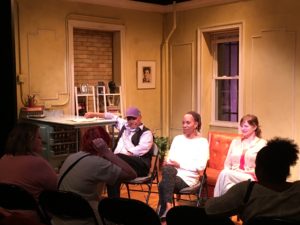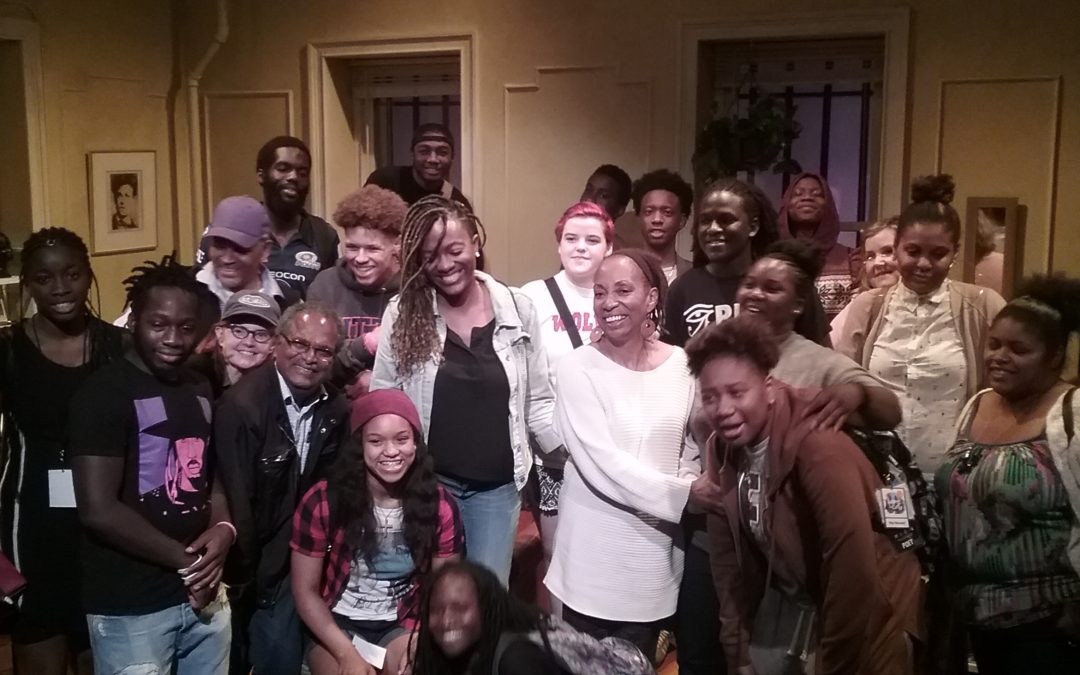 TOWN HALL: Young Chicago Authors
TOWN HALL: Young Chicago Authors
by Kyle Whalen
Say you’re looking at an armchair, in a small Harlem apartment. If you’re trying to strengthen your drawing ability, one way is to look at the armchair, and draw it. If I tried that, my drawing would be rudimentary, symbol-reliant—it wouldn’t really look like the chair in front of me. Perhaps yours would be the same. So, we might try another technique: drawing the chair using negative space. By sketching the apartment around the armchair, we create a more accurate chair shape, and see all of it anew.
Dael Orlandersmith’s poetic one-woman play Beauty’s Daughter works similar magic, developing the character Diane, first by showing her, and then by stepping away from her to show her surroundings world. The play is a ninety-minute journey through East Harlem, starting in Diane’s apartment before shifting to her neighbors, acquaintances, and mother. Each character tells us a story, each shaping this dreamy, jazzy, difficult world a little more.
American Blues Theater’s production opened this weekend, featuring Blues Artistic Affiliate Wandachristine (who is amazing). I saw its final preview last week—a performance paired with a talkback as a Town Hall event for Young Chicago Authors, an organization known for their wide-ranging writing and artistic education programs, notably their youth poetry slam, Louder Than a Bomb.
Seeing Beauty’s Daughter alongside the YCA group rustled me out of my habitual audience member posture. They responded to the play vocally, snapping, sometimes turning to each other and quietly consulting about a line of dialogue or poetry. I admit this is maybe me relying on symbols again: a group of young poets and writers snapping during a poetry-heavy show. But while that atmosphere of play-as-slam and its accompanying vocabulary were familiar to me (especially after seeing Kristiana Rae Colón’s Octagon at Jackalope last year), the YCA folks showed me something else. They didn’t defer to the play as other audiences seem to do. Instead, they readily accepted the audience’s theatrical role as the final collaborator. They took up a different kind of space in the audience—filled up that negative space, you could say. I found myself leaning in, too, trying to be more a part of the play. Their energy boosted Wandachristine’s performance to new height.
A few minutes after the show ends, a delightful talkback begins between Wandachristine, director Ron OJ Parson, and Blues Artistic Director Gwendolyn Whiteside, and the YCA group and a few other audience members. Someone asks, “What inspired the piece?” Whiteside discusses (as in her note here) how Olandersmith wrote from her experience living in East Harlem. Whiteside fell in love with Beauty’s Daughter a while ago, and asked Parson and Wandachristine if they would do it for American Blues.
The questions and comments seem to stem from artists genuinely admiring fellow artists. Many talkbacks I attend feature theatergoers talking about “what they got from the play,” and there’s nothing wrong with that. But the YCA audience probed: “How did you make this?” Some comments were pure congratulation (“I’m glad you made this.”) Sometimes, had a technical bent (“How did you prepare [to play] the white guy?” Wandachristine replies, “A dialect coach, a choreographer, Law & Order, and Goodfellas.”) Another person asked how she develops distinct personas, and Wandachristine explained building a character starts with listening; a soul blossoms from an accent or familiar song, which seems like a useful method for young poets to hear.
The whole exchange is generous, and generous exchange—particularly with young folks—is a central goal for American Blues Theater. The Town Hall event series seeks it. The Lincoln Project offers arts education, mentorship, and exclusive performances for over two thousand students from Chicago Public Schools and surrounding communities. Blues holds food drives, honors military personnel, partners plays with other organizations—which makes sense. If the company’s mission is to produce work exploring American identity, it is right and wise to invite as many identities and groups to the conversation as possible.
After the talkback, many of the teens waited in the lobby, to speak with Wandachristine one-on-one about her career, about her education, about their education, about what can come next in life. On Thursday, I think Wandachristine, Whiteside, and Parson recognized it was one of the best kind of moments in theatre—when a new audience with a fresh perspective shows up and engages the work.
Young Chicago Authors enriched my listening experience, by their presence, by being wonderful artists, ready to play.

